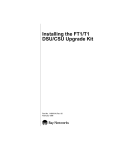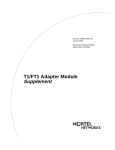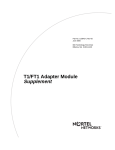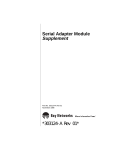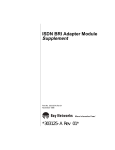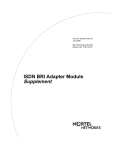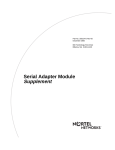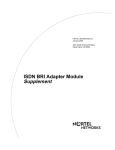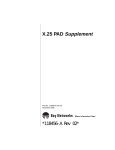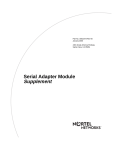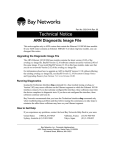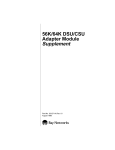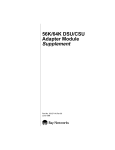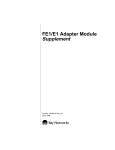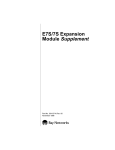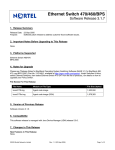Download Avaya FT1/T1 User's Manual
Transcript
FT1/T1 Adapter Module Supplement Part No. 118943-A Rev 01 June 1998 4401 Great America Parkway Santa Clara, CA 95054 8 Federal Street Billerica, MA 01821 Copyright © 1998 Bay Networks, Inc. All rights reserved. Printed in the USA. June 1998. The information in this document is subject to change without notice. The statements, configurations, technical data, and recommendations in this document are believed to be accurate and reliable, but are presented without express or implied warranty. Users must take full responsibility for their applications of any products specified in this document. The information in this document is proprietary to Bay Networks, Inc. Trademarks AN, Quick2Config and Bay Networks are registered trademarks and Advanced Remote Node, ANH, ARN, BayRS, BayStack, BCC, and the Bay Networks logo are trademarks of Bay Networks, Inc. Statement of Conditions In the interest of improving internal design, operational function, and/or reliability, Bay Networks, Inc. reserves the right to make changes to the products described in this document without notice. Bay Networks, Inc. does not assume any liability that may occur due to the use or application of the product(s) or circuit layout(s) described herein. USA Requirements Only Federal Communications Commission (FCC) Compliance Notice: Radio Frequency Notice Note: This equipment has been tested and found to comply with the limits for a Class A digital device, pursuant to Part 15 of the FCC rules. These limits are designed to provide reasonable protection against harmful interference when the equipment is operated in a commercial environment. This equipment generates, uses, and can radiate radio frequency energy. If it is not installed and used in accordance with the instruction manual, it may cause harmful interference to radio communications. Operation of this equipment in a residential area is likely to cause harmful interference, in which case users will be required to take whatever measures may be necessary to correct the interference at their own expense. European Requirements Only EN 55 022 Statement This is to certify that the Bay Networks BayStack AN, ANH, or ARN is shielded against the generation of radio interference in accordance with the application of Council Directive 89/336/EEC, Article 4a. Conformity is declared by the application of EN 55 022 Class A (CISPR 22). Warning: This is a Class A product. In a domestic environment, this product may cause radio interference, in which case, the user may be required to take appropriate measures. EC Declaration of Conformity This product conforms (or these products conform) to the provisions of Council Directive 89/336/EEC and 73/23/EEC. The Declaration of Conformity is available on the Bay Networks World Wide Web site at www.baynetworks.com. ii 118943-A Rev 01 Japan/Nippon Requirements Only Voluntary Control Council for Interference (VCCI) Statement Voluntary Control Council for Interference (VCCI) Statement This is a Class A product based on the standard of the Voluntary Control Council for Interference by Information Technology Equipment (VCCI). If this equipment is used in a domestic environment, radio disturbance may arise. When such trouble occurs, the user may be required to take corrective actions. Canada Requirements Only Canadian Department of Communications Radio Interference Regulations This digital apparatus (BayStack AN, ANH, or ARN) does not exceed the Class A limits for radio-noise emissions from digital apparatus as set out in the Radio Interference Regulations of the Canadian Department of Communications. Règlement sur le brouillage radioélectrique du ministère des Communications Cet appareil numérique (BayStack AN, ANH, or ARN) respecte les limites de bruits radioélectriques visant les appareils numériques de classe A prescrites dans le Règlement sur le brouillage radioélectrique du ministère des Communications du Canada. Canada CS-03 Rules and Regulations Notice: The Industry Canada label identifies certified equipment. This certification means that the equipment meets telecommunications network protective, operational and safety requirements as prescribed in the appropriate Terminal Equipment Technical Requirements document(s). The Department does not guarantee the equipment will operate to the user’s satisfaction. Before installing this equipment, users should ensure that it is permissible to be connected to the facilities of the local telecommunications company. The equipment must also be installed using an acceptable method of connection. The customer should be aware that compliance with the above conditions may not prevent the degradation of service in some situations. Repairs to certified equipment should be coordinated by a representative designated by the supplier. Any repairs or alterations made by the user to this equipment, or equipment malfunctions, may give the telecommunications company cause to request the user to disconnect the equipment. Users should ensure for their own protection that the electrical ground connections of the power utility, telephone lines and internal metallic water pipe system, if present, are connected together. This precaution may be particularly important in rural areas. Caution: Users should not attempt to make such connections themselves, but should contact the appropriate electric inspection authority, or electrician, as appropriate. 118943-A Rev 01 iii Notice: For equipment using loopstart lines, please note that the Ringer Equivalence Number (REN) assigned to each terminal device provides an indication of the maximum number of terminals allowed to be connected to a telephone interface. The termination on an interface may consist of any combination of devices subject only to the requirement that the sum of the Ringer Equivalence Numbers of all the devices does not exceed 5. The REN is located on the “FCC Rules Part 68” label located on the bracket of the module, or on the back of the unit. Canada CS-03 -- Règles et règlements Avis: L'étiquette d'Industrie Canada identifie le matériel homologué. Cette étiquette certifie que le matériel est conforme aux normes de protection, d'exploitation et de sécurité des réseaux de télécommunications, comme le prescrivent les documents concernant les exigences techniques relatives au matériel terminal. Le Ministère n'assure toutefois pas que le matériel fonctionnera à la satisfaction de l'utilisateur. Avant d'installer ce matériel, l'utilisateur doit s'assurer qu'il est permis de le raccorder aux installations de l'entreprise locale de télécommunication. Le matériel doit également être installé en suivant une méthode acceptée de raccordement. L'abonné ne doit pas oublier qu'il est possible que la conformité aux conditions énoncées ci-dessus n'empêche pas la dégradation du service dans certaines situations. Les réparations de matériel homologué doivent être coordonnées par un représentant désigné par le fournisseur. L'entreprise de télécommunications peut demander à l'utilisateur de débrancher un appareil à la suite de réparations ou de modifications effectuées par l'utilisateur ou à cause de mauvais fonctionnement. Pour sa propre protection, l'utilisateur doit s'assurer que tous les fils de mise à la terre de la source d'énergie électrique, des lignes téléphoniques et des canalisations d'eau métalliques, s'il y en a, sont raccordés ensemble. Cette précaution est particulièrement importante dans les régions rurales. Avertissement: L'utilisateur ne doit pas tenter de faire ces raccordements lui-même; il doit avoir recours à un service d'inspection des installations électriques, ou à un électricien, selon le cas. Avis: Veuillez prendre note que pour tout appareillage supportant des lignes de type “loopstart,” l'indice d'équivalence de la sonnerie (IES) assigné à chaque dispositif terminal indique le nombre maximal de terminaux qui peuvent être raccordés à une interface. La terminaison d'une interface téléphonique peut consister en une combinaison de quelques dispositifs, à la seule condition que la somme d'indices d'équivalence de la sonnerie de tous les dispositifs n'excède pas 5. Le REN figure sur l’étiquette “FCC Rules Part 68” située sur le support du module ou à l’arrière de l’unité. FCC Part 68 Compliance Statement This equipment complies with Part 68 of FCC Rules. All direct connections to telephone network lines must be made using standard plugs and jacks compliant with FCC Part 68. Please note the following: 1. You are required to request service from the telephone company before you connect the unit to a network. When you request T1 service, you must provide the telephone company with the following data: • The Facility Interface Code: Provide the telephone company with all the codes below: -- 04DU9-BN (1.544 MB, D4 framing format) -- 04DU9-DN (1.544 MB, D4 framing format with B8ZF coding) -- 04DU9-1KN (1.544 MB, ESF framing format) -- 04DU9-1SN (1.544 MB, ESF framing format with B8ZF coding) -- 04DU9-1ZN (1.544 MB, ANSI ESF and ZBTSI without line power) The telephone company will select the code it has available. • • 2. iv The Service Order Code(s) (SOC): 6.0F The required Universal Service Order Code (USOC) jack: RJ48C Your telephone company may make changes to its facilities, equipment, operations, or procedures that could affect the proper functioning of your equipment. The telephone company will notify you in advance of such changes to give you an opportunity to maintain uninterrupted telephone service. 118943-A Rev 01 3. If the unit causes harm to the telephone network, the telephone company may temporarily discontinue your service. If possible, they will notify you in advance, but if advance notice is not practical, you will be notified as soon as possible and will be informed of your right to file a complaint with the FCC. 4. If you experience trouble with the unit, please contact the Bay Networks Technical Solutions Center in your area for service or repairs. Repairs should be performed only by service personnel authorized by Bay Networks, Inc. United States Valbonne, France Sydney, Australia Tokyo, Japan 5. 1-800-2LAN-WAN 33-4-92-96-69-68 61-2-9927-8800 81-3-5402-0180 You are required to notify the telephone company when you disconnect the unit from the network. 118943-A Rev 01 v Using the FT1/T1 Adapter Module This document supplements one of the following guides: • Installing an Adapter Module in a BayStack AN or ANH Router • Installing and Operating BayStack ARN Routers (Chapter 4, “Installing a WAN Adapter Module”) Follow the hardware installation steps in the guide for your router, referring to this document for information specific to the FTI/T1 adapter module. Information in this supplement includes: • • • • “Verifying Router Requirements” on page 1 “Attaching Cables” on page 2 “Completing Software Configuration” on page 4 “Interpreting LEDs” on page 4 Verifying Router Requirements Table 1 shows the minimum boot and diagnostic programmable read-only memory (PROM) code required for the FT1/T1 adapter modules. Table 1. PROM Diagnostic and Boot Code Requirements Router Type Code Type Minimum Version Directory File Name ARN™ Boot 1.18 arn_proms arnboot.exe Diagnostic 2.00 arn_proms arndiag.exe Boot 9.00c an_proms anboot.exe Diagnostic 7.30 an_proms andiag.exe AN®/ANH™ For information on upgrading PROM, see the BayRS™ Upgrading Routers guide. 118943-A Rev 01 1 FT1/T1 Adapter Module Supplement Attaching Cables Connect the T1 communication device cable to the RJ-48C connector on the installed FT1/T1 adapter module (Figure 1). Complies with FCC Rules Part 68 Reg. Number 4P8USA-31445-DE-N RT1/FT1 DSU/CSU Red Alm Loop Yel Alm Sync AN0125A Figure 1. FT1/T1 Adapter Module Cable Connection and LEDs You install the FT1/T1 adapter module in an open adapter module slot on the router, as follows: • ARN -- one of the two front-panel WAN adapter module slots (Figure 2). See Installing and Operating BayStack ARN Routers. • AN or 12-port ANH -- the back-panel adapter module slot (Figure 3). See Installing an Adapter Module in a BayStack AN or ANH Router. • 8-port ANH -- the back-panel COM3 slot (Figure 4). See Installing an Adapter Module in a BayStack AN or ANH Router. 1 Complies with FCC Rules Part 68 Reg. Number 4P8USA-31445-DE-N FT1/T1 DSU/CSU Red Alm Loop Yel Alm Sync 2 ARN0090A Figure 2. 2 ARN FT1/T1 Adapter Module 118943-A Rev 01 Using the FT1/T1 Adapter Module UL UL XCVR UTP CO M 2 CONSOLE TX RX CL COM 1 100-240V 50-60 Hz 1.0-0.5A RST RLSD2 RLSD1 AN0123A Complies with FCC Rules Part 68 Reg. Number 4P8USA-31445-DE-N FT1/T1 DSU/CSU Figure 3. Red Alm Loop Yel Alm Sync AN or 12-Port ANH FT1/T1 Adapter Module COM 2 COM 1 COM 3/Expansion Red Alm Loop Yel Alm Sync FT1/T1 Complies with FCC Rules Part 68 DSU/CSU Reg. Number 4P8USA-31445-DE-N AN0124A Figure 4. 118943-A Rev 01 8-Port ANH FT1/T1 Adapter Module 3 FT1/T1 Adapter Module Supplement Completing Software Configuration Once you have successfully installed the adapter module, complete the following software configuration tasks using instructions found in your BayRS documentation: Configuration Task Location of Instructions Connect the ARN to the network. One of the following: • Installing and Operating BayStack AN and ANH Routers • Installing and Operating BayStack ARN Routers • Configuring BayStack Remote Access Note that you cannot perform a Netboot or Directed Netboot operation using the FT1/T1 adapter module interface. The boot/startup methods you can use are Local Boot and EZ-Install. Modify the ARN configuration file to add the Any of the following: FT1/T1 module and enable default software • Configuring and Managing Routers with services. Site Manager • Using the Bay Command Console • Configuring Your Router Using the Quick2Config Tool Configure FT1 or T1 services. Configuring WAN Line Services For the latest information, be sure to review the Release Notes and Documentation Changes for your version of BayRS software. Interpreting LEDs The FT1/T1 adapter module has four LEDs that are identical in label, color, and function on each platform (refer to Figure 1). On ARN, AN, and 12-port ANH routers, the LEDs are to the right of the RJ-48C connector. On the 8-port ANH router, the LEDs are to the left of the connector. 4 118943-A Rev 01 Using the FT1/T1 Adapter Module Table 2 describes the function of each FT1/T1 LED. Table 2. FT1/T1 LEDs Label Color Meaning Red Alm Red Lights when the T1 port is in a red alarm state. Yel Alm Amber Lights when the DSU/CSU has received a yellow alarm from the T1 network. Loop Amber Lights when the T1 interface is placed in loopback mode. Sync Green Lights when the T1 port is synchronized with the T1 network. The LEDs will blink on and off during diagnostic testing, but they will not stay on to indicate data transfer until you have configured and enabled FT1/T1 software services. 118943-A Rev 01 5












